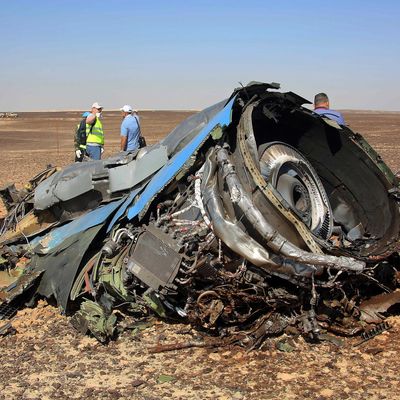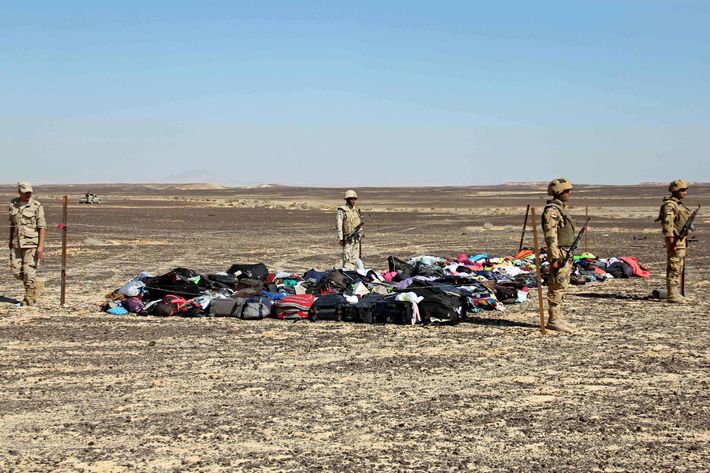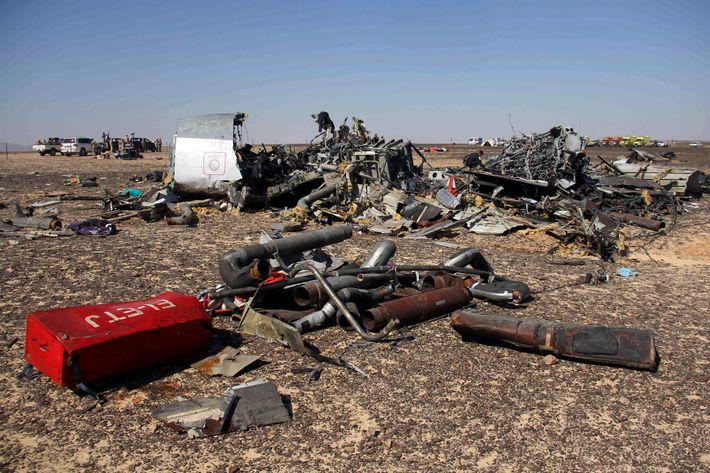
Twenty-three minutes after takeoff this past Saturday, shortly after reaching an altitude of 31,000 feet over Egypt’s Sinai Peninsula, an Airbus A321 flying as Metrojet Flight 9268 abruptly plummeted and crashed, killing all 224 passengers and crew. The suddenness of the loss of communications, the rapidity with which the plane descended, and the size of the area across which the wreckage was scattered indicate that the plane experienced a sudden, catastrophic structural failure at high altitude. But what does that tell us in practical terms?
Given Russian aviation’s rather poor reputation for maintenance, one immediately obvious possibility was that the plane had suffered a severe malfunction. Receiving particular scrutiny was the fact that in 2001 the aircraft’s tail had been repaired after being damaged in a rough landing. This suggested a possible parallel with China Airlines Flight 611, which suffered a catastrophic decompression 20 minutes after taking off from Taipei in 2002. In that case, too, the aircraft’s tail had been fixed after a rough landing years before. When the faulty repair job failed, the airplane was ripped apart with such force that the pilots had no time to make a Mayday call.
Parallels might also be seen with TWA 800, which crashed off the coast of Long Island in 1996. In that case, NTSB investigators concluded that the plane had exploded after faulty wiring caused fumes in a fuel tank to explode, leaving the plane’s pilots no time to radio for help or try to steer the plane to safety.
On Saturday, the New York Times published a story on the Metrojet tragedy that noted that “the fuel tank on one of its planes exploded before departure from the Siberian city of Surgut in 2011, and the ensuing fire killed three people.” That makes it sound like Metrojet planes have a history of exploding fuel tanks, but that’s not really the case: What actually happened in the Surgut incident is that one of the plane’s engines first caught fire, and that fire subsequently caused the fuel tank to explode some minutes later. That is to say, fire preceded explosion, not vice versa. An engine catching fire in flight can be swiftly catastrophic — such an event downed Air France Flight 4590 in 2000 and effectively ended the Concorde’s career — but not swiftly enough to prevent a distress call.

It’s worth noting, too, that in the wake of TWA 800 industry-wide design changes were made to fix the problem, and no similar accidents have occurred in the two decades since.
If mechanical failure did not bring down Metrojet 9268, the other possibility is malice. Apart from a handful of flights like TWA 800 and China Airlines Flight 611, planes that have blown up in air have done so as a result of either being blown up by a bomb carried onboard or after having been hit by a missile. A well-known example of the former would be Pan Am Flight 103, which was downed by a Libyan bomb over Lockerbie, Scotland, in 1988. An example of the latter would be Malaysia Airlines Flight 17, which was destroyed by a Russian-made Buk surface-to-air missile system while flying at 33,000 feet over rebel-held territory in eastern Ukraine.
Given Russia’s recent entanglement in the chaos of Syria, there is no shortage of factions that would be happy to cause it harm, not least ISIS, which in the immediate aftermath of the downing issued a statement declaring, “The fighters of the Islamic State were able to down a Russian plane over Sinai province that was carrying over 220 Russian crusaders.”
A report on the MH17 accident released last month by the Dutch Safety Board specifically cited Sinai as an area in which commercial airline routes might be in danger of attack from the ground. The possibility that a missile strike is to blame has been tacitly acknowledged by several airlines: Emirates, Lufthansa, and Air France have all rerouted their flights away from Sinai.
The thing is, it’s pretty hard to shoot down an airliner at cruise altitude. When it came to grief, Metrojet 9268 was flying six miles above the ground, well out of range of the shoulder-filed anti-aircraft missiles that have proliferated among the region’s various ethno-religious factions. To reach a target that high requires a more sophisticated type of weapon — at a minimum, a vehicle-mounted medium-range surface-to-air missile like Russia’s Buk or the U.S.-made Patriot. Such systems reach altitudes of more than 80,000 feet.
Not many players possess such weapons, however. Not only are they expensive — a Patriot missile costs $2 million to $3 million — but they are so manifestly dangerous that the great powers have been very prudent about distributing them to their proxy fighters. For all the material that ISIS has liberated from the U.S.-supplied Iraqi Army, Patriot missiles are not among them. The Dutch Safety Board report concluded that “there are no indications that point to the presence of medium or long-range surface-to-air missiles.”
Bombs, on the other hand, are easy to obtain. Less than a pound of explosives smuggled into the baggage hold is enough to provide a fatal blast. (Pan Am was destroyed by just 11 ounces of Semtex.) And there is certainly no shortage of motivated parties who might want to punish Russia for its recent decision to commit air and ground forces to the Syrian civil war. The drawback to a bomb, of course, is that they can be thwarted by security measures. One would expect, given the volatility of the region, that airport security in Sharm El-Sheikh would be tight. But in the past year several breaches have been reported.

In the immediate aftermath of an air tragedy it’s often difficult to separate fact from rumor, and Metrojet 9268 has been no exception, with various Russian and Egyptian officials making conflicting claims. Monday afternoon, however, came what seems like a significant development:
A senior defense official told NBC News late Monday that an American infrared satellite detected a heat flash at the same time and in the same vicinity over the Sinai where the Russian passenger plane crashed. According to the official, U.S. intelligence analysts believe it could have been some kind of explosion on the aircraft itself, either a fuel tank or a bomb, but that there’s no indication that a surface-to-air missile brought the plane down.
That same infrared satellite would have been able to track the heat trail of a missile from the ground.
If the report is true, then a Lockerbie-type scenario becomes overwhelmingly the most probable.
That being the case, Metrojet 9268 could well be seen as chickens coming home to roost for Russian president Vladimir Putin, who in the past has shown staggering indifference to civilian casualties. He is widely viewed as being responsible for the bombings of two St. Petersburg apartment blocks in 1999, which killed 300 people and were used to provide pretext for the Second Chechen War. More to the point, he is widely viewed as bearing responsibility for the downing of MH17. If we have entered an era in which civilian airliners have become fair game, no one is more responsible than he.





























